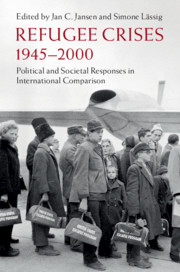Book contents
- Refugee Crises, 1945–2000
- Publications of the German Historical Institute
- Refugee Crises, 1945–2000
- Copyright page
- Contents
- Contributors
- Acknowledgments
- 1 Responses to Refugee Crises in International Comparison
- Part I The Postwar and Decolonization Moment
- 2 The Dynamics of Expellee Integration in Post-1945 Europe
- 3 Integrating without a Host Society
- 4 Pakistan
- 5 Transgenerational Displacement and Integration among Palestinians and Palestinian Refugees from Syria in Jordan
- 6 A Matter of Definition
- Part II Refugee Movements during the Cold War and beyond
- Part III Afterword
- Index
2 - The Dynamics of Expellee Integration in Post-1945 Europe
from Part I - The Postwar and Decolonization Moment
Published online by Cambridge University Press: 13 October 2023
- Refugee Crises, 1945–2000
- Publications of the German Historical Institute
- Refugee Crises, 1945–2000
- Copyright page
- Contents
- Contributors
- Acknowledgments
- 1 Responses to Refugee Crises in International Comparison
- Part I The Postwar and Decolonization Moment
- 2 The Dynamics of Expellee Integration in Post-1945 Europe
- 3 Integrating without a Host Society
- 4 Pakistan
- 5 Transgenerational Displacement and Integration among Palestinians and Palestinian Refugees from Syria in Jordan
- 6 A Matter of Definition
- Part II Refugee Movements during the Cold War and beyond
- Part III Afterword
- Index
Summary
This essay examines the impact of the mass arrival of forced migrants in three post-World War II European polities: West Germany, East Germany, and Finland. All three states faced similar challenges in dealing with the legacies of defeat, territorial loss, and large-scale forced migration while forging new postwar social structures and adapting to the developing Cold War international order. The first was to become a key member of the Western alliance; the second an integral part of the Eastern bloc; and the third a neutral entity. It offers a comparative analysis of refugee reception and integration process in the three states between ca. 1945 and 1970. It placesparticular emphasis on identity-building processes, detailing how the postwar forced migrants, many of whom were initially seen as unwelcome intruders, came to be portrayed in the national narratives of all three states as co-nationals and members of an ethnically homogeneous national community.
Keywords
- Type
- Chapter
- Information
- Refugee Crises, 1945-2000Political and Societal Responses in International Comparison, pp. 29 - 54Publisher: Cambridge University PressPrint publication year: 2020

